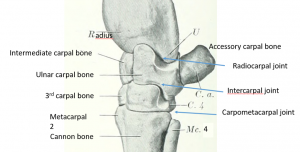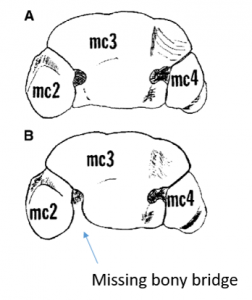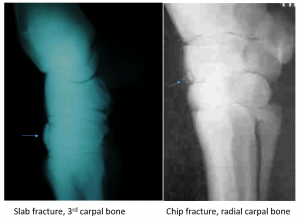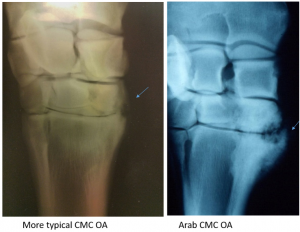Equine joint disorders
Carpal joint problems
Anatomy
There are 3 joints in the carpus : the antebrachiocarpal (radiocarpal), the intercarpal (middle carpal) and carpometacarpal joint. The antebrachiocarpal and intercarpal joints are high motion joints while the carpometacarpal joint is low motion. The intercarpal and carpometacarpal joints communicate in all horses.

Weight bearing is asymmetrical with the axial aspect of the limb bearing more weight and enduring more trauma over time.
Many Arabs of Polish and Russian ancestry have less bony support on the medial aspect of the limb due to a different conformation and are prone to more osteoarthritis at the carpometacarpal joint.

Osteoarthritis
The main problem affecting the carpus (besides sepsis) is trauma and arthritis. Racing horses, in particular, are at significant risk of developing chips or slab fractures.
Diagnosis
Common signs include pain on flexion, bony remodeling of the carpus, and carpal distension.
Radiographs are useful. The most common sites for chips include the distal dorsomedial aspect of the radial carpal bone, the proximal dorsomedial aspect of C3, and the distal radius. Slab fractures (front of bone fractured off) are also found on C3 (third carpal bone) and may be preceded by sclerosis (increased bone) of C3 and/or lysis of C3. Lesions are often bilateral. Radiographs will show small spicules of bone at the joint margins or sharp corners to the bones. The flexed lateral view is useful for determining whether the intermediate carpal bone or radial carpal bone is affected since “radial drops” and “I goes high”.

Arabians with CMC (carpometacarpal) syndrome show an exaggerated, callus-like response

Therapy
Treatment includes removing any chips and treating the joints for any cartilage damage.
Arabian carpometacarpal syndrome is treated with arthrodesis of the intercarpal and carpometacarpal joints if identified prior to changes in the radiocarpal joint. Most of these horses are treated supportively until retirement (usually within months of diagnosis). Pasture turn out, NSAIDs, and frequent trimming are used to maintain comfort.
Key Takeaways
Carpal joint arthritis is most common in
- older Arabs – due to instability of the joint after injury
- race horses – due to chip and slab fractures when the carpus is hyperextended (super straightened) during speed work
Resources
Severe carpometacarpal arthritis in older Arabian horses, Vet Surg 2003
An animal is put into the fenced in pasture and allowed to wander and exercise at will.

